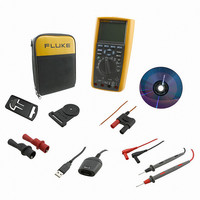FLUKE-289/FVF Fluke Electronics, FLUKE-289/FVF Datasheet - Page 62

FLUKE-289/FVF
Manufacturer Part Number
FLUKE-289/FVF
Description
COMBO KIT DMM & ACCESSORY
Manufacturer
Fluke Electronics
Series
FlukeView® Forms, 28xr
Type
Digital (DMM)r
Datasheet
1.FLUKE-289.pdf
(88 pages)
Specifications of FLUKE-289/FVF
Includes
Battery, Case, Clips, Software, Temperature Probe, Test Leads
Style
Handheld
Display Digits
4.5
Display Type
LCD, Bar Graph
Display Count
50000
Function
Voltage, Current, Resistance, Capacitance, Temperature, Frequency
Functions, Extra
Continuity, dB
Features
Data Logging, Hold, Memory, Min/Max/Ave
Ranging
Auto/Manual
Response
True RMS
Lead Free Status / RoHS Status
Not applicable / RoHS non-compliant
Other names
289/FVF
614-1063
614-1063
287/289
Users Manual
softkeys labeled Prev and Next to select an item for deletion.
Next, press the softkey labeled Delete. A message asking to
confirm the deletion will appear before anything is deleted from
memory.
Recording Measurement Data
The Meter’s record feature collects measurement information
over a user-specified duration. This collection of information is
called a recording session. A recording session is made up of
one or more measurement records. Each record contains
measurement summary information covering the duration of the
record.
Each record contains the minimum, maximum, and average
value detected over the record’s duration. In addition to
measurement values, time stamps are also captured and saved
with each record. The time stamps consist of the record start
time, the time the maximum value was detected, the time the
minimum value was detected, and the record end time.
Some of a records data can be viewed through the Meter’s
Viewing Trend Data function. Viewing all the data that makes up
a record can only be viewed on a PC running FlukeView Forms
software.
There are two measurement record types that are captured
during a recording session: interval and event. An interval record
covers a user-specified interval. An event record has a duration
determined by the activity of the measured signal and can
interrupt an interval record. Even if an interval record is
interrupted, a record will end and a new interval record will begin
when the scheduled interval time expires.
52
Event records are triggered by the measured signal varying more
than an adjustable percentage of the value measured at the start
of the record. This adjustable percent is called the Event
Threshold for recording. In addition to the values and time
stamps mentioned above, an event record also stores whether
the signal was stable or unstable during the event record
duration. To be classified as stable, the measured signal’s value
must stay within the selected percentage of the start value for at
least one second. Measured signals that exceed the percentage
threshold in less than one second are classified as unstable. See
the “Setting the Event Threshold Value” section later in this
manual.
A record ends when one of the following occurs:
A recording session termination can be caused by one of the
following:
For temperature measurements, the AutoHold
threshold is a percent of 100 degrees. The default
AutoHold threshold is 4% of 100 degrees, or 4 degrees
Celsius or Fahrenheit.
The start of a new interval record.
A range overload, causing the Meter to change range.
A non-ranging overload, when in manual range or the
highest range.
The measured value changes more than 4 % of the
measured value at the start of the record.
The recording session terminates.
Note










